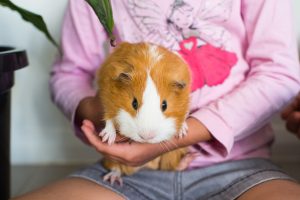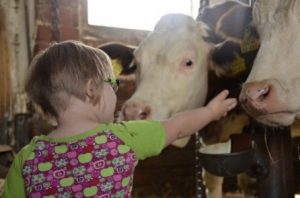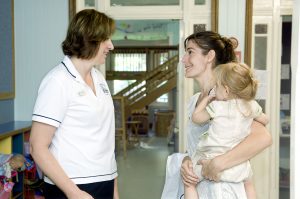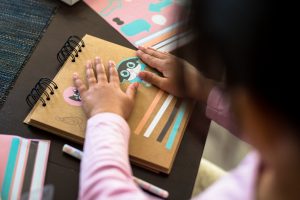15 Inclusive Practice in Early Childhood Education
The image of the child
The starting point for successful inclusive practices is reflecting upon the image of the child. Loris Malaguzzi[1] suggests that the educators’ image of the child directs them in how they talk, listen, observe and relate to children. The image of the child influences how the educator views the child and influences their expectations they have of them. Reflecting on the image of the child shifts the focus back to the child as they are, not just the way they are perceived or labelled.
The image of the child promoted by advocates of inclusive practices, presents the child as being so engaged in experiencing the world and developing a relationship with the world, that he or she develops a complex system of abilities, learning strategies and ways of organising relationships [2]. Children are the “bearer and constructors of their own intelligences”, expressing their leanings in a variety of ways; a process Reggio educators refers to as ‘the hundred languages’ [3].
The NS framework views children’s learning as dynamic, complex, and holistic. Physical, social, emotional, personal, spiritual, creative, cognitive, and linguistic aspects of learning are all interrelated. It allows children to actively construct their own understandings, act independently, and contribute to the learning of others. Children have a right to participate in making decisions that affect them and to have their ideas and opinions welcomed, respected, and valued. Respecting these rights encourages children to share their ideas with confidence and listen to and respect the ideas and opinions of others.[4]
Reflection
- What is your image of the child?
- Do you see the child’s competencies and complexities?
- Is this a child who shares their thinking, theories and wonderings with you or do they censor themselves in adult child interactions?
Getting to know the children
It is important to get to know individual children so that the appropriate support can be offered to them. This is most successfully achieved through discussion with the family and the child and through observation and documentation. Discussions with the family will provide educators with vital information about the child. It is important to ask questions with sensitivity and understanding in talks with parents and to set a tone of welcome for the family that encourages communication and open discussion built on trust and respect.

Conversing with the child about their abilities, needs, and interests empowers the child and increases their sense of agency. Conversations provide the opportunity for the child to verbalise their interests and needs. Observations are a vital tool for early childhood educators to build an understanding of children’s interests, abilities, learning, development and wellbeing [5]. When observing an individual child, it is important to focus on the child’s abilities. Looking beyond a textbook definition of their possible diversity and noting their strengths and what they can do is also helpful. Documenting observations of children professionally and regularly, without labels or diagnoses is also a useful step. Interpreting these observations and applying this information when making decisions about programming and planning that relate to individual children and groups of children is also effective in building an inclusive culture.

Early childhood educators are key in knowing and understanding child development. Understanding that children learn skills in a particular order will help the early childhood educator set realistic expectations for the child’s skill development. As an example a child needs to practice standing before practicing walking. A child with special needs may need to have a skill divided into smaller steps before the skill can be mastered.
Inclusive environments
The importance of high quality early years education and care has been well documented [6][7] [8] [9] [10]. Participation in inclusive high-quality early childhood settings is fundamental to supporting children to build positive identities, develop a sense of belonging and realise their full potential. Supporting children’s positive individual and group identity development in ELCC is fundamental to realising children’s rights. Inclusive environments provide the space for the recognition of gender, ability, culture, class, ethnicity, language, religion, sexuality and family structure as integral to society [11].
Carefully planned environments engage and enable children to co-construct learning and build deeper understandings [12]. The educator’s image of a child and the environment they create are strongly connected. Creating an environment that supports the inclusion of every child means each child can be supported to thrive and build a respect and valuing of diversity. High quality education and care is characterised by thoughtfully designed environments that support intentional, structured interactions to scaffold children’s growth and learning. Quality child-care contributes to the emotional, social, and intellectual development of children.
A starting point in creating an inclusive environment is to pay close attention to the physical environment. Does the physical environment meet the needs of the children and support children to engage naturally with things that interest them? Physically inclusive spaces maximise each child’s opportunity to:
- access and explore indoor and outdoor areas as independently as possible;
- make choices about the resources they access and the experiences they participate in;
- interact meaningfully with other children and adults;
- care for themselves as independently as possible;
- experience challenge and take managed risks;
- engage with images, books and resources that reflect people with disabilities as active participants in and contributors to communities in a variety of ways [13].

When adapting the physical environment to include a child with a disability, it is important to consider what needs to be altered or added to enable the child to manage daily routines and experiences as independently as possible. How accessible are the resources for the child? Do items need to be placed at a different height or level so that the child can reach them?
Considering issues of fairness and equity at the level of the individual child and the group and providing appropriate adaptations that allow diverse children to participate in the classroom curriculum is an effective strategy as well [14]. Attention to the physical demands of daily classroom activities for example may support classroom wide intervention [15]. For example, moving a painting activity from an easel to a tabletop for all children may offer support for those who find it difficult to stand and paint for long periods [16]. Adaptations to the indoor and outdoor environments that increase children’s access to activities might be effective in supporting peer interaction [17]. For example, a child with a communication difficulty may benefit from using visual resources such as pictorial flow charts to help them understand and participate in the day’s routines and activities [18]. Inviting all children to become familiar with the visual resources and encouraging them to support those who are unsure is another useful strategy. A child who experiences high levels of anxiety or behavioural issues may need a safe, quiet area to go to when they feel overwhelmed or want time away from the group[19]. Such additions to the environment often benefit all children. It is beneficial to include strategies that support children’s independence as they access the class resources to undertake their learning. Educators in classrooms make use of a large variety of ideas and strategies to enable learner’s independence. Visit the resource below and make a note of the different ideas one teacher has used to create an inclusive prep classroom in a Queensland primary school. Use these ideas to begin your own collection of strategies and build upon the list as you continue to engage with ideas around creating inclusive classrooms.
Cultural competence
In creating an inclusive physical environment, a shared culture of inclusion can be modelled and supported. Children are naturally curious about the people around them as they attempt to develop a sense of their own identity. One way of achieving this is by defining what makes them different from everyone else. A child may ask questions about observable characteristics like skin colour, accent, or manner of dress. “Children are around two or three when they begin to notice physical differences among people” [20]. Questions about characteristics such as “Why is Kiah’s skin brown?” are not motivated by any intention to offend or hurt. Educators can use these opportunities to send a fair and accurate message about each diversity, so that children learn that these differences make a person unique. The educator can utilise these encounters with diversity to enrich all children’s learning.
Diversity, Equity, and Cultural Competence[21]
Cultural competence is a core component of high-quality early childhood education programs, and it is incumbent upon us to ensure that they are attending to the critical questions and implications of diversity, equity, and cultural competence at every stage of the development and implementation from standards and curriculum, to outreach and engagement, to monitoring and evaluation.
Intentional Teaching[22]
Early childhood pedagogy The term pedagogy is a fairly new term to educators across Nova Scotia. The term pedagogy stems from the Greek terms paÍs (child) and ágõ (to lead, to guide). Pedagogy refers to the holistic nature of an educator’s professional practice, especially those aspects that involve building and nurturing relationships. Early childhood pedagogy is different than a program plan, or defined activities intended to produce a defined outcome. It encourages educators to ask questions—about what they do, and why—and what impact their decisions have on how children learn. Pedagogy informs curriculum decision-making, and the facilitation of learning in a rich and inviting child-centered environment.
Early childhood pedagogy is not focused on merely providing experiences for children. It also encourages educators to observe children, engage in conversations, and guide children’s activities based on what they learn. In this way, the curriculum is co-constructed by children and educators. At the same time, educators explore and learn from families and communities, which helps to inform the construction of curriculum. When educators view children as capable learners and establish respectful and caring relationships with them and their families, everyone works together to co-construct curriculum and learning experiences relevant to children in their local context. These experiences gradually expand children’s knowledge and understanding of the world. Professional judgement is a key component of early childhood pedagogy, and central to facilitating children’s learning. It requires educators to be reflective and intentional, to consider what they do, why they practice as they do, and how their actions impact children and their families. Professional judgement is driven by a vision of children’s potential. In making professional judgements, educators weave together their • professional knowledge of child development, children’s learning, and skills to guide children’s learning in an intentionally planned play-based environment • knowledge of children, families and communities, and cultural traditions • awareness of how their beliefs, values, and Image of the Child impact children’s learning Nova Scotia’s early learning framework is a social pedagogical framework that emphasizes relationships and experiences.
It builds on developmental (Is this appropriate for a two-year old’s stage of development? What activities would help to develop these skills for three-year olds?), and socio-cultural perspectives (What do I need to consider about this child’s family and cultural background? Are the books in our library representative of the families and cultures of the children in the program?), and emphasizes the need for fairness, justice and equity for all children (Do all children have the same chance for success at this activity? Is the language we use free of bias about gender, race?).
Involving families
Families of children with diversity have the same needs for ELCC as do other families. Inclusive ELCC environments offer all families the opportunity to engage in regular life patterns [23]. Offering inclusive settings removes barriers and provides the opportunity for all children to engage in high quality ELCC that may enhance their learning and developmental success.
Be clear and transparent
At the outset inform all families about the setting’s philosophy in regard to inclusion and diversity. When educators and families have different views regarding this, the educator may need to seek support from colleagues and draw on the centre policies for guidance.
Pay attention to settling-in
Every family can face challenges when settling into a new ELCC setting, as each child must adjust from their home culture to the culture of the service. Children from different backgrounds, minority groups or a child with a disability may face an extra challenge as they undergo this transition from their home to the setting. The cultural and educational approach of the setting, which is generally based on the values and perspectives of the majority population, may be new to families. It is essential that such families feel confident that the settling-in process will support, and be appropriate to, their child’s needs.
Support families when asked
Educators play an important role in helping families support and guide their child’s learning and development in positive and effective ways. When families are well-supported by educators they may be better equipped to nurture their child’s learning and development [24]. Families may need support, and educators need to respond in non-judgemental ways. As with so many areas of communication and relationships, it helps if the educator can put themselves in the shoes of the family and think about how they (the educators) may feel in the same situation. Developing collaborative partnerships that involve respectful communication about all aspects of a child’s learning and development helps both parties to adopt a holistic and consistent approach. Taking a professional approach supports educators in presenting a positive attitude to families, working collaboratively to identify options to solve problems.
Providing the family with professional advice about their child’s learning and development, including their strengths and their psychological, social and emotional development is important. Families do not always know where to go to for assistance to act on the information provided. Recommending reliable sources of information and support for families in their local community and beyond is vital. The early childhood educator regularly serves as the conduit between families in need and agencies structured to assist. Educators with a sound knowledge of the variety of support systems available for the community group associated with the ELCC setting is best equipped to be of assistance here.
Communicate with families
It is important that educators identify children’s learning needs and respond quickly to any concerns they may have. Communicating concerns about a child to the parents is often a difficult step. Success is more likely if this step is taken from an already-existing relationship that is built on trust and respect. Even when this relationship is in place, educators need to plan what they will say about concerns for the child. A discussion of this nature should take place in a private location, with adequate time allowed, and, if applicable, both parents in attendance.
The first step is to ask the family members how they see the child and then to share the positive qualities observed within the ELCC setting. At the outset, it is helpful for educators to let the family know that:
- They share concerns for the child.
- Their intent is to support the child’s development.

In order to do this, educators need to get some ideas for how to best meet the child’s needs. If family members differ in their view of the child, be open to their perspective, ask questions, gather information, and invite them to be your partner in meeting the needs of their child. When done respectfully, this communication can lead to a fruitful exchange of ideas and ultimately help for the child.
Negotiate multiple agency involvement
While in an early childhood program, children with special needs may receive additional therapy from specialists. Early childhood professionals are key in partnering with the family and other professionals in the provision of support services for the child. Communication with those providing specialist support helps to coordinate the activities of the child. Educators play an important role in working with parents to support their children. Successful engagement between educators, families, professionals, agencies and community members enable the sharing of information that ultimately support children’s learning and development. Strong partnerships between these sites also help vulnerable children feel more secure [25]. By working with families, professionals and agencies, educators may have access to helpful information and strategies to manage or guide children’s learning and development.
Empowering Children
Educators who enact thoughtful and informed curriculum decisions and work in partnership with families and other professionals provide children with the greatest opportunity for success. Enabling child agency through considered curriculum and program design empowers children to engage confidently with their own learning and development. By purposefully planning experiences and engaging in nurturing, non-directive interactions with children, staff can optimise children’s learning. Supporting children’s agency enables them to make choices and decisions, and influence events and their world. Appropriate choices provide children with an opportunity to implement their emerging skills and develop a strong sense of identity. A practical strategy is to implement strategies, practice and programs that support every child to work with, learn from and help others through collaborative learning opportunities.
It is important to acknowledge children as individuals with a range of skills, emotions and experiences, both at home and at the setting, that may impact on how they cope being part of a group setting on any given day. Children’s learning is most effective when staff members are responsive and make the most of the spontaneous skill learning opportunities that arise in children’s everyday experiences. For children to learn to guide their own behaviour they need help to understand expectations and what is acceptable. For example, they may not understand why they have to wait to use the new equipment; why they cannot draw on the walls; why it is not appropriate to pull someone’s hair to get them to move. The answers to these questions are not always obvious to children. Empower children by acknowledging their understandings and supporting them as they develop new knowledge.
Play-based Pedagogy as a Tool for Inclusive Education and Diversity
ELCC settings serve a wide range of children with various needs, backgrounds, abilities, genders, cultures, languages, and interests. Play based learning experiences are at the heart of early education [26]. Children make sense of their world through their play and engage in the social world of their peers when they are playing. They benefit from the opportunities play offers to make decisions, predictions and solve problems. Where children are supported in play, they actively interact with others to create experiences to develop the skills and rewarding relationships that are fundamental to their personal growth and development across physical, social, emotional and cognitive domains [27]). They create valuable learning opportunities for themselves through their interactions with their world and the people in it [28]. Children learn to transfer their social and emotional skills and understandings to new situations through play and interactions with their peers.
Shipley[29] suggests the following principles relating to learning through play. Children learn:
• when given plenty of opportunities for sensory involvement.
• through exploration and experimentation where they are free to move and pursue self-paced activities at their individual developmental level.
• by doing and interacting with real objects in a playful learning environment.
• most effectively if they are interested in what they are learning and free to choose to play in their own way.
• in an environment where they experience psychologically safety, a place where risk taking and mistake making are acceptable and where encouragement is offered in a timely manner that supports a learning moment.
• by uncovering concepts through open-ended exploratory play.
• most effectively when they progress from concrete to abstract concepts involving simple to more complex levels of knowledge, skill, and understanding, and where they can make sense of general concepts through to specific concepts.
• by revisiting prior knowledge, previously acquired skills, and concepts in manner that reinforces the transference of knowledge from a known context to application in a new context.
• most effectively when their experiences of play build on what they already know, and can take one step further, what is known as a zone of proximal development at a pace that is scaffolded to suit the
individual.

Play-based pedagogy is well suited to supporting diversity and inclusive education, as it incorporates the interests, insights and backgrounds of all the children [30]. Educators who embrace a play-based pedagogy are responsive to the individual strengths and needs of children, which lead to a naturally inclusive environment [31]. Within a play-based learning environment, educators have the opportunity to adapt the environment and resources routinely to promote optimal learning experiences for all students based on individual development, interests, strengths and needs. Educators are key in encouraging children to be independent. Children like to do things on their own and it is better for the development of children, to encourage them to do whatever they can for themselves. A play-based setting supports this approach.The role of the educator is integral to supporting children’s learning and development. Educators provide support (i.e., scaffold) to extend the duration and complexity of children’s play as well as encourage children to incorporate language, literacy, and numeracy within their play [32]. When teachers consider individual children’s abilities, interests and preferences, they create an environment that is engaging for all.
To support all children to learn and develop through play, Wood[33] suggests educators:
• plan, resource and create challenging learning environments;
• support each child’s learning via intended play activity;
• extend and support play that is spontaneous;
• develop and extend each child’s communication in play;
• assess each child’s learning through play promoting continuity and facilitating progression;
• combine child-initiated play with adult-directed activities;
• accentuate well-planned, purposeful play in both outdoor and indoor settings;
• plan for connection between work and play activities;
• provide time for children to engage deeply in work activities; and
• scaffold opportunities for engagement connecting children and adults.
When enacting play-based pedagogies educators are able to recognise the discoveries being made by children as they construct their own knowledge, in their own ways [34]. Curriculum objectives will be met in an integrated program, allowing for depth as well as breadth as children make meaning from the world around them. Play-based approaches open a setting to all learning possibilities in a way that inclusion happens as part of every-day life and diversity is welcomed and celebrated.
conclusion
It is the right of every child to be provided with the opportunity to learn and develop to the best of their ability. Early childhood educators are required to facilitate effective, inclusive pedagogies and programs in the both childcare and school settings to cater for the diverse children and families who may attend their site. Strategies and ideas for developing diverse classrooms have been suggested in this chapter.
Conclusion Activity
Managing inclusivity within your classroom will require flexible and creative approaches. Reflecting upon the information provided above prioritise 5 approaches you will utilise to create a more inclusive environment. Use resources such as those provided via the websites below to begin your list.
Resources for educators
- Capable, Confident, and Curious: Nova Scotia’s Early Learning Curriculum Framework
- Department of Education and Early Childhood Development website.
Attribution
This chapter is adapted from Chapter 4 Opening eyes onto inclusion and diversity in early childhood education by Michelle Turner in Opening Eyes by Susan Carter; Professor Lindy-Anne Abawi; Professor Jill Lawrence; Associate Professor Charlotte Brownlow; Renee Desmarchelier; Melissa Fanshawe; Kathryn Gilbey; Michelle Turner; and Jillian Guy shared with a CC BY-NC license.
- Malaguzzi, L. (1994). Your image of the child: where teaching begins.Child Care Information Exchange (96), 52-61. ↵
- Rinaldi, C. (2013). Re-imagining childhood. Adelaide, SA: Government of South Australia. ↵
- Ibid. ↵
- Enter your footnote content here. ↵
- Colville, M. (2018). Observation-based planning. Chap 11 pg 319-354. In Estelle Irving & Carol Carter, The Child in focus: Learning and teaching in early childhood education pp. 319-354). South Melbourne, VIC: Oxford Press. ↵
- Dahlberg, G., Moss, P., & Pence, A. (2007). Beyond quality in early childhood education and care: Languages of evaluation (2nd ed.). London, England: Falmer Press ↵
- Dearing, E., McCartney, K., & Taylor, B. (2009). Does higher quality early child care promote low-income children’s math and reading achievement in middle childhood? Child Development, 80(5), 1329-1349. doi:10.1111/j.1467-8624.2009.01336.x ↵
- Peisner-Feinberg, E., Buysse, V., Fuligni, A., Burchinal, M., Espinosa, L., Halle, T., & Castro, D. (2014). Using early care and education quality measures with dual language learners: A review of the research. Early Childhood Research Quarterly, 29, 786-803. doi: 10.1016/j.ecresq.2014.04.013 ↵
- Sylva, K. (2010). Introduction: Why EPPE? In K. Sylva, E. Melhuish, P. Sammons, I. Siraj-Blatchford, & B. Taggart (Eds.), Early childhood matters: Evidence from the effective pre-school and primary education project (pp.1-7). Abingdon, England: Routledge. ↵
- Torii, K., Fox, S., & Cloney, D. (2017). Quality is key in Early Childhood Education in Australia. (Mitchell Institute Policy Paper No. 01/2017). Melbourne, Victoria: Mitchell Institute. Retrieved from:www.mitchellinstitute.org.au ↵
- Queensland Government Department of Education. (2018b). Respect for diversity. Retrieved from https://qed.qld.gov.au/earlychildhood/about-us/transition-to-school/information-schools-ec-services/action-area-research/respect-for-diversity ↵
- Queensland Studies Authority. (2010). Queensland kindergarten learning guideline. Brisbane, QLD: Author ↵
- Owens, A. (2012). Curriculum decision making for inclusive practice. National Quality Standard Professional Learning Program, 38, 1-4. Retrieved from: http://www.earlychildhoodaustralia.org.au/nqsplp/wp-content/uploads/2012/07/NQS_PLP_E-Newsletter_No38.pdf ↵
- Diamond, K., & Hong, S. (2010). Young children’s decisions to include peers with physical disabilities in play. Journal of Early Intervention, 32, 163–177. ↵
- Brown, W., Odom, S., McConnell, S., & Rathel, J. (2008). Peer interactions for preschool children with developmental difficulties. In W. B. Brown, S. L. Odom, & S. R. McConnell (Eds.), Social Competence of Young Children with Disabilities: Risk, Disability, and Intervention(pp. 141-164). Baltimore, MD: Paul H. Brookes. ↵
- Sandall, S., & Schwartz, I. (2008). Building blocks for teaching preschoolers with special needs. Baltimore, MD: Paul H. Brookes. ↵
- Diamond, K., & Hong, S. (2010). Young children’s decisions to include peers with physical disabilities in play. Journal of Early Intervention, 32, 163–177. ↵
- (Owens, 2012) ↵
- Owens, A. (2012). Curriculum decision making for inclusive practice. National Quality Standard Professional Learning Program, 38, 1-4. Retrieved from: http://www.earlychildhoodaustralia.org.au/nqsplp/wp-content/uploads/2012/07/NQS_PLP_E-Newsletter_No38.pdf ↵
- Kupetz, B. (2012). Do you see what is happening? Appreciating diversity in early childhood settings. (Online). Early Childhood News. Retrieved from http://www.earlychildhoodnews.com/earlychildhood/article_view.aspx?ArticleID=147 ↵
- paragraph from NAYEC. (n.d.). Diversity, Equity, and Cultural Competence. https://www.naeyc.org/our-work/public-policy-advocacy/cultural-competence ↵
- Province of Nova Scotia Department of Education and Early Childhood Development. (2018). Capable, Confident, and Curious: Nova Scotia’s Early Learning Curriculum Framework. https://www.ednet.ns.ca/docs/nselcurriculumframework.pdf ↵
- Jansson, B., & Olsson, S. (2006). Outside the system: Life patterns of young adults with intellectual disabilities. Scandinavian Journal of Disability Research, 8(1), 22-37. doi:10.1080/15017410500301122 ↵
- Hunter Institute of Mental Health. (2014). Connections: A resource for early childhood educators about children’s wellbeing. Canberra, ACT: Australian Government Department of Education. ↵
- Hunter Institute of Mental Health. (2014). Connections: A resource for early childhood educators about children’s wellbeing. Canberra, ACT: Australian Government Department of Education. ↵
- Booth, T., Ainscow, M., & Kingston, D. (2006). Index for inclusion: Developing play, learning and participation in early years and childcare. Bristol: Centre for Studies in Inclusive Education. ↵
- KidsMatter. (n.d.). Early Childhood: A framework for improving children’s mental health and wellbeing.Retrieved from https://www.kidsmatter.edu.au/early-childhood/kidsmatter-early-childhood-practice/framework-improving-childrens-mental-health-and ↵
- Siraj-Blatchford, I. & Sylva, K. (2004). Researching pedagogy in English pre-schools. British Educational Research Journal, 30(5), 713-730. ↵
- Shipley, D. (2013). Empowering children: Play-based curriculum for lifelong learning. Toronto, ON: Nelson Education. ↵
- Siraj-Blatchford, I. & Sylva, K. (2004). Researching pedagogy in English pre-schools. British Educational Research Journal, 30(5), 713-730. ↵
- (McLean, 2016) ↵
- McLean, C. (2016). Full–day kindergarten play-based learning: Promoting a common understanding.Department of Education and Early Childhood Development, Government of Newfoundland and Labrador. Retrieved from: https://www.ed.gov.nl.ca/edu/pdf/FDK_Common_Understandings_%20Document_Eng_2016.pdf ↵
- Wood, E. (2007). New directions in play: Consensus or collision? Education 3-13, 35(4), pp.309-320. doi: 10.1080/03004270701602426 ↵
- McLean, C. (2016). Full–day kindergarten play-based learning: Promoting a common understanding.Department of Education and Early Childhood Development, Government of Newfoundland and Labrador. Retrieved from: https://www.ed.gov.nl.ca/edu/pdf/FDK_Common_Understandings_%20Document_Eng_2016.pdf ↵

